Haojin Li
No Vision, No Wearables: 5G-based 2D Human Pose Recognition with Integrated Sensing and Communications
Dec 31, 2025Abstract:With the increasing maturity of contactless human pose recognition (HPR) technology, indoor interactive applications have raised higher demands for natural, controller-free interaction methods. However, current mainstream HPR solutions relying on vision or radio-frequency (RF) (including WiFi, radar) still face various challenges in practical deployment, such as privacy concerns, susceptibility to occlusion, dedicated equipment and functions, and limited sensing resolution and range. 5G-based integrated sensing and communication (ISAC) technology, by merging communication and sensing functions, offers a new approach to address these challenges in contactless HPR. We propose a practical 5G-based ISAC system capable of inferring 2D HPR from uplink sounding reference signals (SRS). Specifically, rich features are extracted from multiple domains and employ an encoder to achieve unified alignment and representation in a latent space. Subsequently, low-dimensional features are fused to output the human pose state. Experimental results demonstrate that in typical indoor environments, our proposed 5G-based ISAC HPR system significantly outperforms current mainstream baseline solutions in HPR performance, providing a solid technical foundation for universal human-computer interaction.
Empower Low-Altitude Economy: A Reliability-Aware Dynamic Weighting Allocation for Multi-modal UAV Beam Prediction
Dec 30, 2025Abstract:The low-altitude economy (LAE) is rapidly expanding driven by urban air mobility, logistics drones, and aerial sensing, while fast and accurate beam prediction in uncrewed aerial vehicles (UAVs) communications is crucial for achieving reliable connectivity. Current research is shifting from single-signal to multi-modal collaborative approaches. However, existing multi-modal methods mostly employ fixed or empirical weights, assuming equal reliability across modalities at any given moment. Indeed, the importance of different modalities fluctuates dramatically with UAV motion scenarios, and static weighting amplifies the negative impact of degraded modalities. Furthermore, modal mismatch and weak alignment further undermine cross-scenario generalization. To this end, we propose a reliability-aware dynamic weighting scheme applied to a semantic-aware multi-modal beam prediction framework, named SaM2B. Specifically, SaM2B leverages lightweight cues such as environmental visual, flight posture, and geospatial data to adaptively allocate contributions across modalities at different time points through reliability-aware dynamic weight updates. Moreover, by utilizing cross-modal contrastive learning, we align the "multi-source representation beam semantics" associated with specific beam information to a shared semantic space, thereby enhancing discriminative power and robustness under modal noise and distribution shifts. Experiments on real-world low-altitude UAV datasets show that SaM2B achieves more satisfactory results than baseline methods.
Fundus Image Quality Assessment and Enhancement: a Systematic Review
Jan 20, 2025Abstract:As an affordable and convenient eye scan, fundus photography holds the potential for preventing vision impairment, especially in resource-limited regions. However, fundus image degradation is common under intricate imaging environments, impacting following diagnosis and treatment. Consequently, image quality assessment (IQA) and enhancement (IQE) are essential for ensuring the clinical value and reliability of fundus images. While existing reviews offer some overview of this field, a comprehensive analysis of the interplay between IQA and IQE, along with their clinical deployment challenges, is lacking. This paper addresses this gap by providing a thorough review of fundus IQA and IQE algorithms, research advancements, and practical applications. We outline the fundamentals of the fundus photography imaging system and the associated interferences, and then systematically summarize the paradigms in fundus IQA and IQE. Furthermore, we discuss the practical challenges and solutions in deploying IQA and IQE, as well as offer insights into potential future research directions.
AIF-SFDA: Autonomous Information Filter-driven Source-Free Domain Adaptation for Medical Image Segmentation
Jan 06, 2025



Abstract:Decoupling domain-variant information (DVI) from domain-invariant information (DII) serves as a prominent strategy for mitigating domain shifts in the practical implementation of deep learning algorithms. However, in medical settings, concerns surrounding data collection and privacy often restrict access to both training and test data, hindering the empirical decoupling of information by existing methods. To tackle this issue, we propose an Autonomous Information Filter-driven Source-free Domain Adaptation (AIF-SFDA) algorithm, which leverages a frequency-based learnable information filter to autonomously decouple DVI and DII. Information Bottleneck (IB) and Self-supervision (SS) are incorporated to optimize the learnable frequency filter. The IB governs the information flow within the filter to diminish redundant DVI, while SS preserves DII in alignment with the specific task and image modality. Thus, the autonomous information filter can overcome domain shifts relying solely on target data. A series of experiments covering various medical image modalities and segmentation tasks were conducted to demonstrate the benefits of AIF-SFDA through comparisons with leading algorithms and ablation studies. The code is available at https://github.com/JingHuaMan/AIF-SFDA.
Multi-Beam Integrated Sensing and Communication: State-of-the-Art, Challenges and Opportunities
May 31, 2024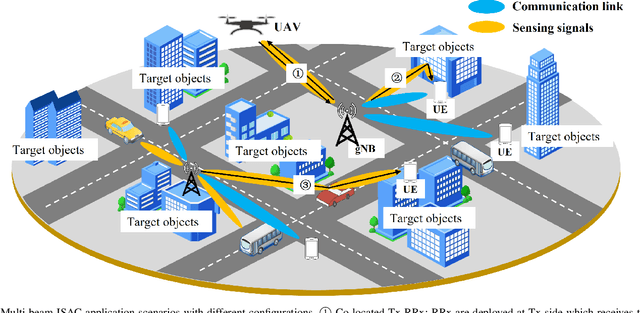
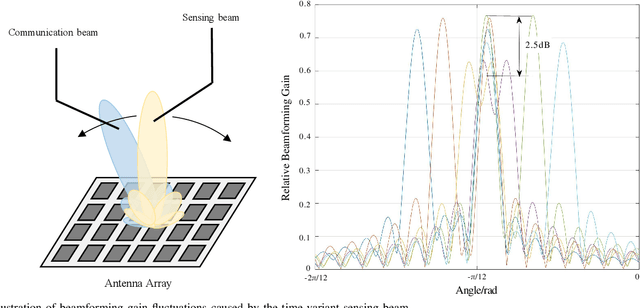
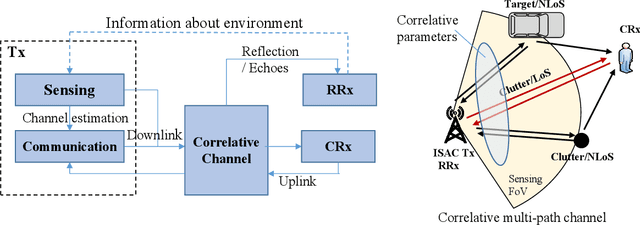
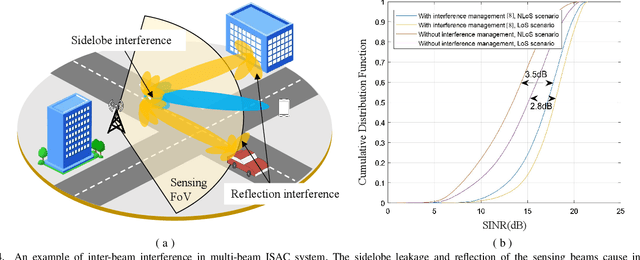
Abstract:Integrated sensing and communication (ISAC) has been envisioned as a critical enabling technology for the next-generation wireless communication, which can realize location/motion detection of surroundings with communication devices. This additional sensing capability leads to a substantial network quality gain and expansion of the service scenarios. As the system evolves to millimeter wave (mmWave) and above, ISAC can realize simultaneous communications and sensing of the ultra-high throughput level and radar resolution with compact design, which relies on directional beamforming against the path loss. With the multi-beam technology, the dual functions of ISAC can be seamlessly incorporated at the beamspace level by unleashing the potential of joint beamforming. To this end, this article investigates the key technologies for multi-beam ISAC system. We begin with an overview of the current state-of-the-art solutions in multi-beam ISAC. Subsequently, a detailed analysis of the advantages associated with the multi-beam ISAC is provided. Additionally, the key technologies for transmitter, channel and receiver of the multi-beam ISAC are introduced. Finally, we explore the challenges and opportunities presented by multi-beam ISAC, offering valuable insights into this emerging field.
RaffeSDG: Random Frequency Filtering enabled Single-source Domain Generalization for Medical Image Segmentation
May 02, 2024



Abstract:Deep learning models often encounter challenges in making accurate inferences when there are domain shifts between the source and target data. This issue is particularly pronounced in clinical settings due to the scarcity of annotated data resulting from the professional and private nature of medical data. Despite the existence of decent solutions, many of them are hindered in clinical settings due to limitations in data collection and computational complexity. To tackle domain shifts in data-scarce medical scenarios, we propose a Random frequency filtering enabled Single-source Domain Generalization algorithm (RaffeSDG), which promises robust out-of-domain inference with segmentation models trained on a single-source domain. A filter-based data augmentation strategy is first proposed to promote domain variability within a single-source domain by introducing variations in frequency space and blending homologous samples. Then Gaussian filter-based structural saliency is also leveraged to learn robust representations across augmented samples, further facilitating the training of generalizable segmentation models. To validate the effectiveness of RaffeSDG, we conducted extensive experiments involving out-of-domain inference on segmentation tasks for three human tissues imaged by four diverse modalities. Through thorough investigations and comparisons, compelling evidence was observed in these experiments, demonstrating the potential and generalizability of RaffeSDG. The code is available at https://github.com/liamheng/Non-IID_Medical_Image_Segmentation.
Frequency-mixed Single-source Domain Generalization for Medical Image Segmentation
Jul 18, 2023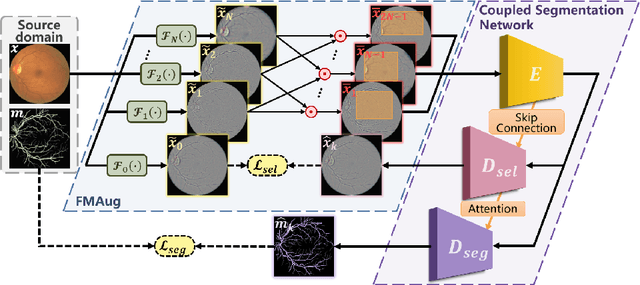
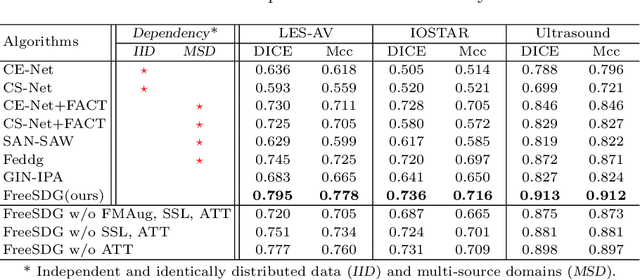

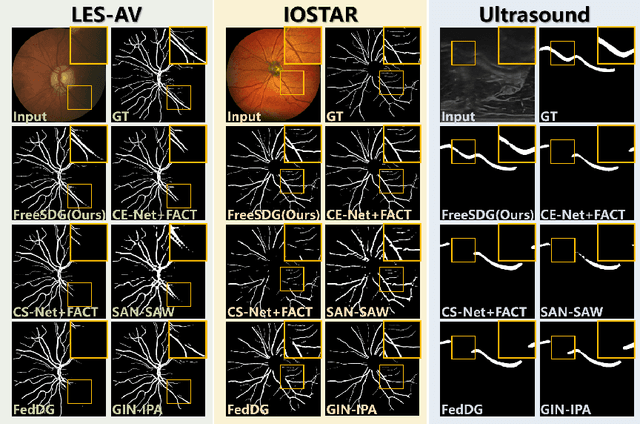
Abstract:The annotation scarcity of medical image segmentation poses challenges in collecting sufficient training data for deep learning models. Specifically, models trained on limited data may not generalize well to other unseen data domains, resulting in a domain shift issue. Consequently, domain generalization (DG) is developed to boost the performance of segmentation models on unseen domains. However, the DG setup requires multiple source domains, which impedes the efficient deployment of segmentation algorithms in clinical scenarios. To address this challenge and improve the segmentation model's generalizability, we propose a novel approach called the Frequency-mixed Single-source Domain Generalization method (FreeSDG). By analyzing the frequency's effect on domain discrepancy, FreeSDG leverages a mixed frequency spectrum to augment the single-source domain. Additionally, self-supervision is constructed in the domain augmentation to learn robust context-aware representations for the segmentation task. Experimental results on five datasets of three modalities demonstrate the effectiveness of the proposed algorithm. FreeSDG outperforms state-of-the-art methods and significantly improves the segmentation model's generalizability. Therefore, FreeSDG provides a promising solution for enhancing the generalization of medical image segmentation models, especially when annotated data is scarce. The code is available at https://github.com/liamheng/Non-IID_Medical_Image_Segmentation.
 Add to Chrome
Add to Chrome Add to Firefox
Add to Firefox Add to Edge
Add to Edge